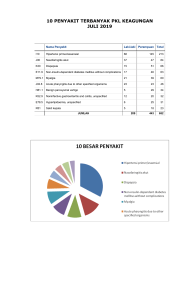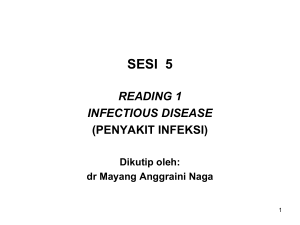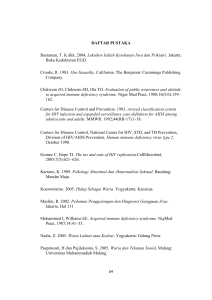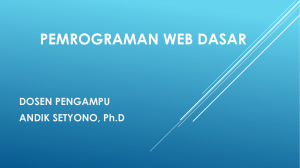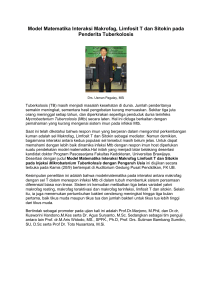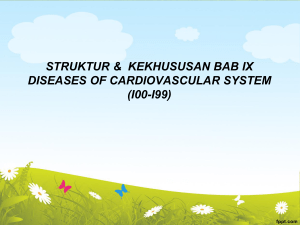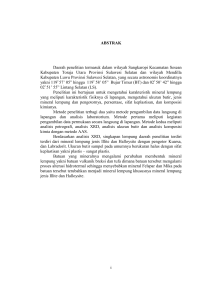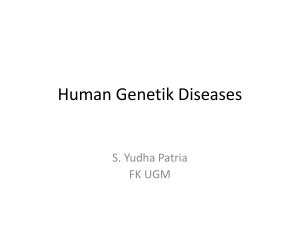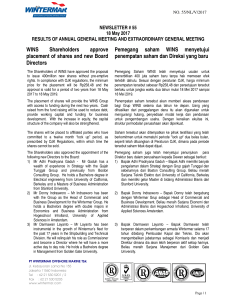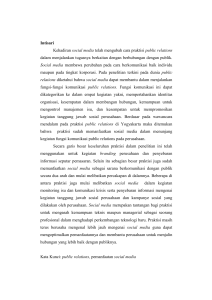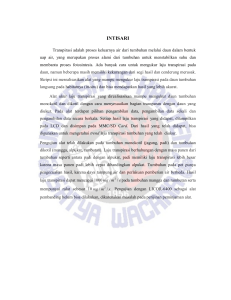pemeliharaan kesehatan geriatri
advertisement
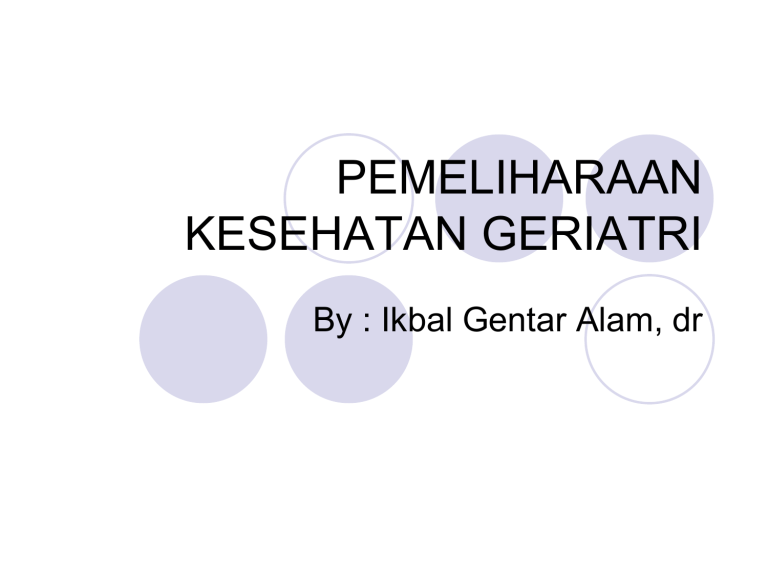
PEMELIHARAAN KESEHATAN GERIATRI By : Ikbal Gentar Alam, dr Pendahuluan Status Kesehatan Promotif Preventif Curatif Rehabilitatif Usia Lanjut Status Kesehatan => Preventif & Rehabilitatif Preventif pada Pemeliharaan Kesehatan Skrening : Penapisan penyakit atau kecacatan dengan melakukan tes, pemeriksaan atau prosedur lain yang dapat dilakukan secara cepat untuk menentukan apakah orang yang terlihat sehat mungkin mempunyai penyakit atau tidak. Bentuk Skrening Tes : Survey epidemiologi pada komunitas Penemuan kasus (case finding) Usia Lanjut fokus terutama pada penyakit, kelemahan, trauma, komplikasi iatrogenik dan masalah psikososial. Efektifitas preventif tergantung pada kesehatan fisik, kemampuan fungsional dan status kognisi. Tindakan preventif dilakukan berdasarkan kondisi umum dari subjek mis ; Kesehatan (60-70% dari usia lanjut), penyakit kronis (20-35%), kelemahan (2-10%) Usia lanjut yg sehat : (minimal atau tidak punya penyakit kronis dan secara fungsional independen) Primer dan sekunder prevention dr penyakit prevention dari kelemahan Usia lanjut dengan penyakit kronis secara fungsional independen atau minimal dependen membutuhkan obat obatan secara rutin dan kadang harus dirawat di rumah sakit karena kambuhnya penyakit. Tertier prevention dari penyakit prevention dari kelemahan. Diikuti dengan : primer & sekunder prevention dr pnykt Prevention dari iatrogenik komplikasi Prevention dari trauma /accident Usia lanjut dengan kelemahan dan penyakit kronis, secara fungsional dependen, kehilangan fungsi fisiologis sering dirawat di RS. Prevention dari trauma / accident Prevention dari komplikasi iatrogenic Bbrp tindakan preventif untuk semua usia lanjut spt : aktifitas fisik / OR, vaksin influenza dll. Usia Lanjut dan Pendamping Lansia Usia lanjut yg sehat : Secara rutin kontrol ke sarana layanan kesehatan primer, exercise secara teratur dan diet sehat. Usia lanjut dengan penyakit kronis : Bersama denga pendampingnya harus memahami penyakitnya dan rencana pengobatannya. Kunjungan rutin ke sarana kesehatan dan melaporkan semua perubahan yang terjadi akan mengurangi kekambuhan penyakitnya dan pada akhirnya mengurangi angka perawatan. Pendamping usia lanjut dengan kelemahan harus bekerja dengan tekun untuk mencegah trauma / accident dengan memastikan keamanan di rumah dan tindakan tindakan lain yang dianggap perlu. Prevention dari Penyakit Primer prevention : Menghentikan penyakit sebelum itu terjadi, mengurangi atau menghilangkan faktor resiko. Mis : vaksin, konseling untuk terapi tingkah laku Sekunder prevention : Penyakit terdeteksi dini dan diterapi pada tahap awal untuk mengurangi angka kesakitan dan angka kematian. Tertier Prevention : Penyakit kronis yang sudah ada dicegah supaya tidak menyebabkan penurunan fungsional lebih lanjut. Lansia dengan penyakit penyakit kronis dapat memetik manfaat dari tertier prevention ini. Arthritis : OA/RA terjadi pada >= usia 65 th sebanyak 50%. Menyebabkan keterbatasan gerak, meningkatkan resiko osteoporosis. Aerobik, penurunan BB dapat mengurangi keluhan yang ada. Osteoporosis : Pengukuran bone density dapat mendeteksi osteoporosis sebelum terjadi fracture. Suplemen kalsium, exercise dan tidak merokok dapat membantu mencegah osteoporosis lebih lanjut. Diabetes : hiperglikemia, terutama Hb A1c > 7,9% meningkatkan resiko retinopathy, neuropathy, nephropathy dan penyakit jantung. Edukasi pasien, pemeriksaan kaki pada setiap kunjungan akan membantu mencegah foot ulcer. Penyakit Vaskular : Lansia dengan riwayat CAD, CVD. Resiko dapat dikurangi dengan manajemen faktor resiko vaskular (hipertensi, merokok, diabetes, atrial fibrilasi, hiperlipoproteinemi) Gagal Jantung : Angka kematian signifikan tinggi pada lansia, pengobatan yang agresif, pembatasan aktifitas dan obat obatan rutin dapat membantu menurunkan angka kesakitan dan kematian. Penyakit Paru Obstruktif Kronik (PPOK) : Stop merokok, penggunaan obat inhaler dan obat lain dengan tepat dan edukasi pasien dapat menurunkan angka kekambuhan. Prevention dari kelemahan Kelemahan : kelemahan, kehilangan BB, kelemahan otot, intoleran exercise, sering jatuh, susah bergerak, ketidakstabilan, inkontinens dll. Exercise dan diet sehat diberikan untuk mencegah atau mengurangi kelemahan walaupun belum terbukti keefektifannya. Exercise mungkin mengurangi resiko kelemahan pada orang muda dan kelemahan lebih lanjut pada usia lanjut. Latihan beban dapat meningkatkan masa tulang dan mencegah resiko terjatuh dan patah tulang. Diet sehat mencegah atau mengurangi penyakit penyakit yang berperan pada kelemahan. Prevention dari Accident / Trauma Terjatuh : Usia lanjut sangat mudah mengalami trauma dari terjatuh Bahaya Mengemudi : manajemen dari kondisi kondisi tertentu, pemeriksaan tes mengemudi berkala dapat mengurangi resiko. Bahaya Di rumah. Prevention dari Komplikasi Iatrogenik Faktor Resiko : Multipel penyakit kronis Multipel tenaga kesehatan Multipel obat & pemakaian obat yg tdk tepat Perawatan di RS Intervensi Case manajemen Team interdisiplin geriatri Apoteker konsultasi Akut care lansia Medical record Prevention dari Masalah Psikososial Skrening depresi sangat dianjurkan karena depresi sangat umum terjadi pada lansia. Lansia yg kesepian dan terisolasi butuh pendamping / tenaga sosial. Meningkatkan kontak sosial mencegah angka kesakitan dan menunda kematian. Depresi Konseling & obat obatan Rehabiltasi Proses penyembuhan yang bertujuan untuk memaksimalkan kemampuan fungsional melalui pengobatan terhadap ketidakmampuan. Keberhasilan partisipasi aktif penderita Proses ketidakmampuan (+) identifikasi f/ intrinsik dan f/ ekstrinsik Rencana rehabilitasi multidisiplin tim Provider Rehabilitasi Physician Physicaltherapist Occupationaltherapist Vocational Counselor Dietitian RecreationalTherapist Disease Impairment Disability Handicap Speechtherapy Nursing personel Social worker Psychologist Prostethist Others (kinesiotherapist) Treatment provided by physicians largely acts at the disease or impairment level. an internist may give a patient a cortisone injection to reduce inflammation caused by trochanteric bursitis. a reduction in disability (improved gait), and a possible improvement in ability to maintain social roles through participation in leisure activities. (such as playing golf or hiking). a surgeon may place an artificial knee in a patient with severe osteoarthritis. Physicians may also act as leaders of the rehabilitation team, particularly physiatrists, neurologists, orthopedists, and geriatricians. Physician referral is often required for the patient to gain access to rehabilitation providers, i.e., the physician acts as gate keeper. Thus, it is incumbent on the geriatric physician to be familiar with the role and function of specific rehabilitation providers. Physical therapy (PT) affects primarily the impairment and disability levels. Physical therapists work most specifically with the musculoskeletal and neurologic systems. evaluation of joint range of motion and muscle strength exercise training to increase range of motion, strength, endurance, and coordination evaluation of mobility (gait or wheelchair) and need for mobility aids and training in their use treatment with physical modalities, including heat, cold, ultrasound, massage, electrical stimulation, iontophoresis, and so on home safety evaluation, sometimes in conjunction with occupational therapy. Occupational therapy (OT) is largely directed at the disability and handicap levels. evaluate and train patients in self-care activities and activities of daily living. They recommend and train patients in the use of assistive devices and adaptive equipment for self-care. work with the cognitive aspects of independent living skills such as the handling of money, safety in the kitchen, and other issues requiring proper judgment. Compensatory techniques to adjust for sensoryperceptual or motor deficits are taught. They may address prevocational and leisure time issues with patients and their families. OTs and physical therapists (PTs) work together to maintain the patient's range of motion and strength, especially in the upper extremities. OTs may also work in conjunction with speech therapists and nutritionists to help treat difficulties with self-feeding and dysphagia. Speech therapists work mainly with patients with impairments and disabilities and secondarily with handicapping circumstances. Help patients with all aspects of communication, and they participate in the evaluation and management of patients with swallowing disorders. evaluation of cognitive skill and aphasia in patients with cortical dysfunction. Management of patients with laryngectomy and other head and neck surgical procedures evaluation of swallowing on radiographs, by endoscope, and at the bedside. Nursing personnel have roles and functions that span the entire spectrum from disease to handicap. Some nurses have specialized training in rehabilitation. facilitating the patient's independent performance of activities of daily living during daily care. Give information and education for caregivers and as such may act to reduce both disability and handicap. Help patients manage self-medication, independent bowel and bladder activity, and prevention of secondary complications such as pressure ulcers, as well as provide medication, nutrition, and wound care. Social workers direct their efforts primarily toward reducing handicapping circumstances. Perform tasks of evaluation, disposition counseling, and liaison with the community. Evaluate the patient's social, physical, and financial home environment. Engage family, community, government, and other resources to assist patients in returning to an appropriate setting for their new level of function. Dietitians have the greatest impact at the impairment level by preventing or reducing nutritional deficiencies, which can retard recovery from a disability (e.g., reduction of muscle mass due to protein malnutrition reduces strength and exacerbates disability). Assess the patient's nutritional status and suggest alterations in the patient's diet to maximize nutrition. In conjunction with speech pathologists and occupational therapists, they may treat eating disorders, for example, by altering the consistency of the diet for patients with dysphagia. Recreational therapists influence the patient at the level of handicap—that is, the ability to maintain social roles and carry on leisure activities. Facilitate the use of organized leisure activities and usually work with patients in group settings, emphasizing social interactions. Personal leisure activities such as hobbies and avocations are used by the recreational therapist to improve self-reliance and self-care. Such activities may help the patient adjust to a new disability. Recreational therapy can be helpful in achieving the goal of community reintegration Vocational counselors influence the level of handicap by helping patients return to the work environment. Patients may be able to return to their previous employment with adaptations, or they may be assessed for alternative employment. Usually see patients near the end of their inpatient rehabilitation stay or after discharge. Even in the geriatric setting, vocational counseling may be an important component of the rehabilitation process. Psychologists are included on the rehabilitation team if testing is needed to assess the patient's psychological or cognitive abilities or if there is a need for counseling. Psychiatrists may be consulted for assessment and pharmacologic treatment of patients with disorders such as depression or dementia, which can interfere with the rehabilitation process. Both psychologists and psychiatrists may be involved in providing counseling and psychotherapy to assist the patient in making adjustments to changes resulting from the new disability. Prosthetists fabricate and fit braces and other orthotic devices, particularly those for the feet, lower limbs, and back. When an individually fitted orthotic device or splint is needed for the upper extremity, it is usually fabricated by the occupational therapist. kinesiotherapists also known as corrective therapists) work alongside physical and occupational therapists. Kinesiotherapists emphasize long-term maintenance of fitness and conditioning. Music therapists and horticulture therapists can also provide useful services in the treatment of disabled elderly patients and can have beneficial effects on the quality of life of these patients. Training STRENGTH TRAINING PROGRAMS IN THE ELDERLY High-Intensity Strengthening Programs consist of progressive resistive training in which the participant lifts 70% to 90% of a one-repetition maximum (the amount of weight that can be lifted fully through the range of motion one time only) three times per week for at least 8 to 10 weeks. The load is increased weekly to maintain the intensity of the stimulus. Usually two to three sets of 10 are repeated per muscle group per exercise session. Strength gains of up to 200% have been reported using these exercise programs. Low-Intensity Strengthening In patients who have conditions that make it difficult to exercise, lower-intensity training is an acceptable alternative method for achieving modest increases in strength. Can lowerintensity strength training achieve the same effects on gait and function as high-intensity strengthening? The few studies that have looked specifically at measures of performance after low-intensity strength training have shown mixed results. Osteoarthritis patients showed improvement in the functional status index with decreases in dependency, difficulty, and pain. AEROBIC EXERCISE TRAINING IN THE ELDERLY BALANCE TRAINING IN THE ELDERLY Specific balance training programs have been advocated as a means of improving postural reactions and reducing falls in older persons. The impact of static and dynamic balance training on measures of gait and balance in healthy and impaired older persons has been reported in a few studies COMBINED EXERCISE PROGRAMS Nutrisi Food provides essential and nonessential nutrients for the metabolic needs as well as the growth and maintenance of our body systems. An essential nutrient is defined as one that cannot be produced in the body from ingested food and therefore must be supplied by the diet. Identification of essential nutrients became feasible when investigators in the field of nutrition and metabolism developed purified diets. Useful indicators that reflect the withdrawal of an essential nutrient in healthy older adults are nitrogen balance and body weight. The essential nutrients that have been identified in this fashion can be divided into macronutrients and micronutrients based on the daily amount of the essential nutrient required in humans. For macronutrients this amount is more than 100 mg/day, and for micronutrients it is less than 100 mg/day. Nutrients can also be divided into organic products (proteins, essential fatty acids, vitamins) and inorganic factors (water, minerals, trace elements). Gastrointestinal System The gastric mucosa changes with age, leading to an increase in nonparietal cells. This may result in a decline in gastric acid output, which may influence the absorption of certain essential nutrients, including vitamin B12, folic acid, and iron. The intestine's ability to absorb food particles generally does not change significantly, but declines in the metabolism and absorption of carbohydrates (especially lactose), calcium, and iron may occur. Taste and Smell Sensation Several changes take place with age in the senses of taste and smell. Taste sensitivity may decline with age, but the evidence is inconclusive and varies significantly among individuals. Age-associated declines in the number of lingual papillae and salivary flow may be associated with diminished taste sensation. Age-associated changes in taste and smell sensation make the discrimination and enjoyment of food difficult and therefore may contribute to undernutrition. NUTRITIONAL REQUIREMENTS OF OLDER PEOPLE Caloric Requirements Caloric requirements decline by approximately 22% from age 30 to age 80. One third of this decline is believed to be due to a decrease in metabolic rate secondary to a decline in lean body mass with age. The remaining two thirds of this decline are due to a decline in energy expenditure secondary to a decrease in physical activity. The decline in caloric requirements and caloric intake in older people puts them at high risk for undernutrition of various essential nutrients. No stress, minimal activity 25 kcal/kg/day Mild stress (e.g., upper respiratory tract infection, grade I to II pressure ulcer) 30 kcal/kg/day Moderate stress (e.g., grade III pressure ulcer, urinary tract infection, pneumonia) 35 kcal/kg/day Severe stress (e.g., sepsis, grade IV pressure ulcer) 40 kcal/kg/day Protein Requirements The current recommendations for protein intake in older people is 0.8 g/kg body weight. A balanced diet of a healthy older adult should contain 12% to 14% of the total caloric intake from various protein sources. During periods of stress, such as during infection or trauma, the protein intake should be increased to 1.0 to 1.5 g/kg body weight. Vitamin and Mineral Requirements In general, healthy older people eating a balanced diet do not need a multivitamin and mineral supplement. However, such supplements may be valuable in a subgroup of older people who are at higher risk for developing deficiencies of calories, proteins, and micronutrients. Fluid or Water Intake Older people are at increased risk for dehydration due to age-associated declines in thirst sensation, inadequate fluid intake, and excessive fluid loss. Subgroups of older people at highest risk for dehydration include nursing home residents, patients with dementia, patients with chronic debilitating illness, and patients taking multiple medications. Recommended fluid intake (water) is 30 mL/kg body weight/day. NUTRITIONAL ASSESSMENT BODY MASS INDEX Body mass index (BMI) is a ratio of body weight (kg) to the square of body height (m2). BMIs of 23 or less and 30 or more have been shown to be associated with increased mortality in the 60-year and older age group. In other words, the association of BMI and mortality is a U-shaped curve in people 60 years and older. Furthermore, the BMI associated with minimal mortality increases with advancing age. Therefore, a BMI that may be considered excessive in a 20-year-old person may be normal for a person who is 60 years old. The formula for calculating BMI is as follows: BMI = BW (kg) / h2 m2 TERIMAKASIH
